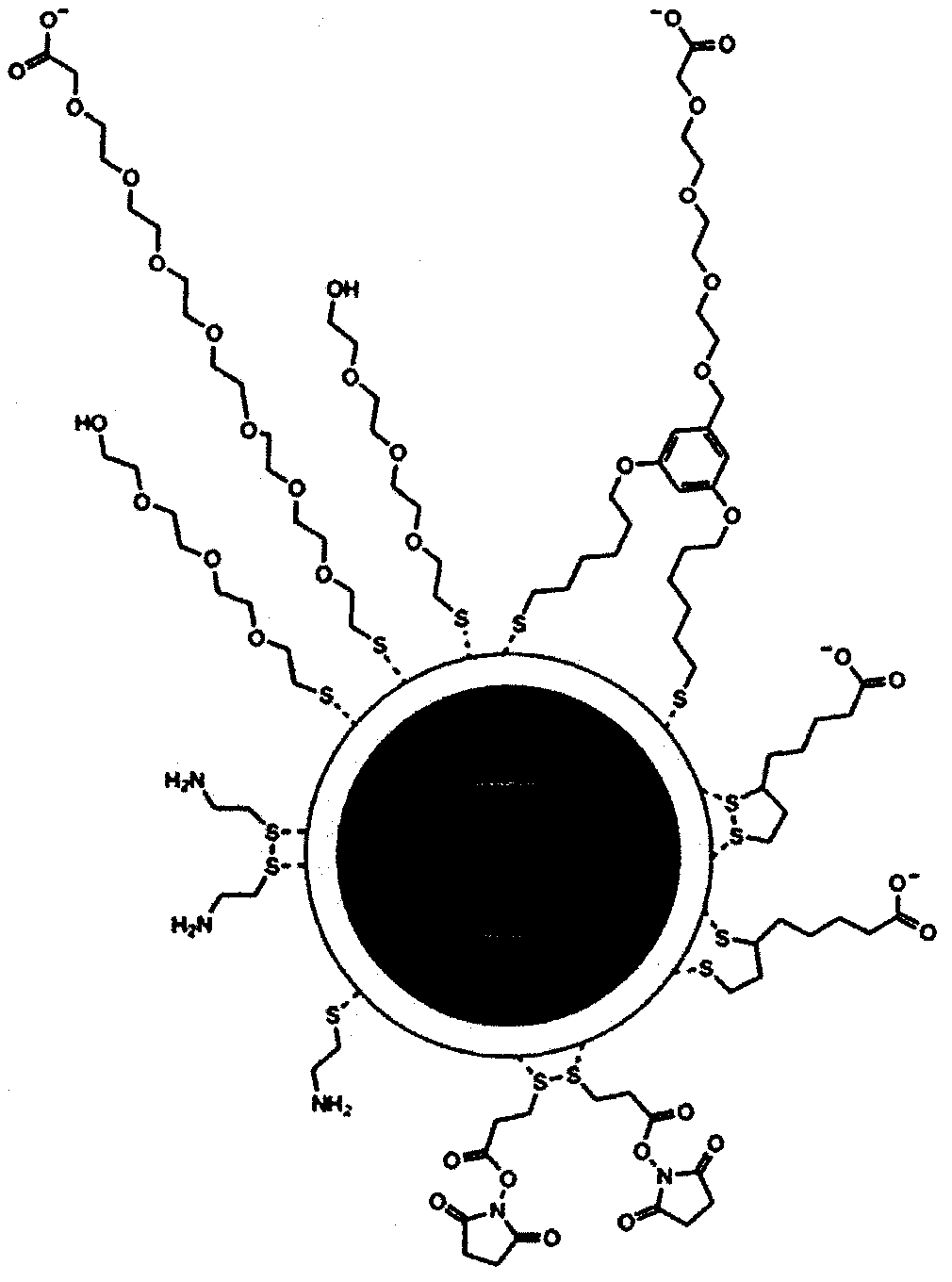Preparation method of poly(sulfydryl)-modified composite nanoparticle probe of covalent coupling antibody
A technology of composite nanoparticles and covalent coupling, which is applied in the direction of measuring devices, instruments, scientific instruments, etc., can solve the problems of false positive results, instability, agglomeration and oxidation of immunodiagnostic results, and eliminate the influence of steric hindrance, which is not easy to detachment effect
- Summary
- Abstract
- Description
- Claims
- Application Information
AI Technical Summary
Problems solved by technology
Method used
Image
Examples
Embodiment 1
[0021] Fc of covalently conjugated antibodies modified with mercaptooctadecanoic acid and mercapto-polyethylene glycol-carboxylates 2 o 3 Preparation of Au / Au composite nanoparticle probes:
[0022] 1) To prepare magnetic nanoparticles, FeCl 3 ·6H 2 O and FeSO 4 ·7H 2 O was added to the deoxidized hydrochloric acid solution to dissolve evenly. During the dissolution process, nitrogen protection was introduced to prevent oxidation. Add ammonia water at 25°C, stir rapidly for 20min, then heat the solution to 60°C in a water bath, and keep for 1 ~2h, collect magnetic nanoparticles with a magnet, wash with water several times, and store in water at low temperature.
[0023] 2) To prepare gold nanoparticles, pour 200mL of water into a 500mL beaker, then add 2mL of HAuCl 4 4H 2 O solution, place it on a magnetic constant temperature stirrer and heat it. When the liquid reaches a sub-boiling state (the temperature reaches about 98°C), quickly add 4mL sodium citrate solution to...
Embodiment 2
[0027] Fc of covalently conjugated antibodies modified with mercaptooctadecanoic acid and mercapto-polyethylene glycol-carboxylates 2 o 3 / Au / Ag composite nanoparticle probe preparation:
[0028] Using the same Fe as in Example 1 2 o 3 / Au composite nanoparticle preparation method, the prepared Fe 2 o 3 / Au composite nanoparticles were dispersed in water, and 0.7 mL of AgNO was slowly added while stirring 3 and sodium citrate mixed solution, and at the same time add HCHO solution and NH 3 ·H 2 O adjusts the pH of the solution to 10 and forms Fe 2 o 3 / Au / Ag composite nanoparticles, the product is magnetically separated, washed with water several times and then dried to constant weight.
[0029] to Fe 2 o 3 / Au / Ag composite nanoparticles were modified with polysulfhydryl groups, and the blank group was set as unmodified Fe 2 o 3 / Au / Ag composite nanoparticles, the test group was Fe modified by a mixture of mercaptooctadecanoic acid and mercapto-polyethylene glycol-...
Embodiment 3
[0031] Fc of covalently conjugated antibody modified by cystine and mercaptooctadecanoic acid 2 o 3 / Au / Ag composite nanoparticle probe preparation:
[0032] Using the same Fe as in Example 2 2 o 3 / Au / Ag composite nanoparticle preparation method and the same modification coupling condition steps, set the blank group as unmodified Fe 2 o 3 / Au / Ag composite nanoparticles, set the experimental group cystine and mercaptooctadecanoic acid mixed with Fe modified by 3:2 2 o 3 / Au / Ag composite nanoparticle, after the functional group modification and activation is successful, it is coupled with antibody protein to form a probe.
PUM
| Property | Measurement | Unit |
|---|---|---|
| Particle size | aaaaa | aaaaa |
Abstract
Description
Claims
Application Information
 Login to View More
Login to View More - R&D Engineer
- R&D Manager
- IP Professional
- Industry Leading Data Capabilities
- Powerful AI technology
- Patent DNA Extraction
Browse by: Latest US Patents, China's latest patents, Technical Efficacy Thesaurus, Application Domain, Technology Topic, Popular Technical Reports.
© 2024 PatSnap. All rights reserved.Legal|Privacy policy|Modern Slavery Act Transparency Statement|Sitemap|About US| Contact US: help@patsnap.com








